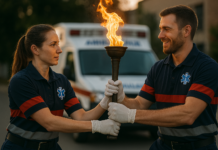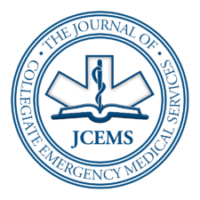Sneakers. Nike sneakers, I think, to be specific. The Lieutenant on Duty at Five Quad Volunteer Ambulance Service (FQVAS or Five Quad) on the State University of New York at Albany (SUNY Albany) campus sent me home because of a pair of sneakers. On my first shift in EMS, I was sent home. After being practically overwhelmed with excitement for days, anxiously awaiting my first chance to actually ride on an ambulance as part of a crew, I was declared unfit for duty and sent home. All because I wore white sneakers with my EMS uniform polo and navy blue EMS pants. I wore my sneakers because my sneakers were so much more comfortable than the heavy black boots that I was supposed to wear and I didn’t think that any patient would care. After all, I was going to save their life so who cares what shoes I wore while I did so?
My First Lesson in EMS
Little did I know that on that day, Lieutenant Jordan Arnold would deliver my first lesson in EMS – if you want to be treated like a professional, you need to act like a professional – which includes a professional appearance. Jordan probably doesn’t even remember the exchange from over two decades ago, but I’ll never forget it. He was firm in his conviction but also took the time to explain to a “newbie” why it was so important to be professional. In a sense, he was my first EMS educator because he made the effort to mentor me instead of simply disciplining me. I was upset, angry, heartbroken, and disappointed in myself. However, from then on, I remembered to wear a neat and clean uniform that epitomized professionalism. I took pride in being a professional and I learned a valuable lesson that day.
As an aside, Lieutenant Jordan Arnold did pretty well for himself after his collegiate EMS days at SUNY Albany. Jordan went on to get his J.D. and currently works with K2 Intelligence, where he serves as a senior managing director in the New York and Los Angeles offices, and as head of the firm’s Private Client Services practice. He leads complex engagements on behalf of high-profile and high-net-worth individuals, family offices and their advisors, private and public entities, financial services, and law firms. Not a bad person from whom to learn a lesson about professionalism and ethics!
Professionalism in Collegiate EMS
Collegiate EMS is such a special and valuable subset of EMS. While many agencies suffer from burn-out and low-staffing, collegiate EMS agencies thrive from a pool of energetic, driven, and community-oriented individuals who are eager to learn and serve. Having said this, collegiate EMS has its own burdens, too. It may forever be seen as, “a bunch of kids playing on an ambulance,” regardless of their extensive training or the fact that they hold the same state and national certifications as other EMS agency providers. Despite the challenges facing a young adult trying to figure out how to delicately balance school, work, a social life, and EMS, I still think that collegiate EMS is a wonderful and worthwhile investment with many valuable lessons.
We are all capable of being professionals and
the public and our patients deserve nothing less.
Having said this, one of the largest issues facing collegiate EMS, and EMS as a whole, is an actual or perceived lack of professionalism and ethical behavior. Our perception by the public we serve, allied health, and public safety professionals is at times embarrassing. For example, consider how EMS providers dress. If you’ve ever attended a large EMS conference, you have seen the vendor tables filled with EMS-style garments. You may have also seen them on social media platforms as ads. They all seem to depict EMS providers as heroes or as god-like warriors. Some say things like, “we rush in when your time has run out,” and have an enormous Star of Life with flames and ribbons adorning it on the back. Others say things like, “Feel Safe & Sleep with an EMT,” or “Real Women Love EMTs.” I thought I had seen it all until I saw, at a recent major conference, a pair of EMS yoga pants with a big pink Star of Life on the hip and “EMT” down one leg in six-inch letters. I nearly lost it, standing right there among my fellow “professionals.” The lines were 3-4 people deep at the table, most of them raving about how cool the items looked. I completely understand, and support, the underlying pride for our profession, but some of these garments are absurd and only degrade us in the eyes of the true professionals.
Let me ask you something. Have you ever seen a surgeon mowing his lawn in a full set of scrubs, wearing his surgical cap and face mask? Have you ever seen an off-duty police officer put on her uniform and then walk through the mall with her friends? Perhaps you’ve seen a designer license plate, denoting that the driver is a hardworking administrative assistant who is integral to her office’s success? Have you ever gone to your physician’s office only to have the physician walk into your exam room wearing a t-shirt and shorts? No. No. No. No. Of course you haven’t. Because that would be ridiculous and unprofessional. So, I ask you, why do we think it’s appropriate to walk around in public in our uniforms or in unprofessional shirts from the conference vendors or social media ads? It’s even worse when I spot someone in a bar with a company t-shirt on. If we want to be treated like professionals, we need to act like professionals. It’s understandable to wear a company, non-uniform t-shirt every now and then that commemorates a specific event but we need to think seriously about how we present ourselves and our profession to the public and our patients.
Changing the Culture
A few years ago, as our campus EMS Advisor, I counseled a member of our collegiate EMS agency because he was constantly seen in full uniform, walking the campus and attending classes. When I first mentioned it, he said that he had a shift that night and didn’t want to have to go back to his dorm room to change clothes, but we both knew he wore it to show off that he was an EMT. I felt horrible talking to him about it, because he was doing it out of pride. He loved that he was an EMT and he lived and breathed for our agency. However, he didn’t realize that by wearing the uniform in public, when he wasn’t actively on duty, he was sending a message to the general public that he was ready to respond to an emergency – which he was not. He also didn’t realize that when he was standing in line at the campus eatery with his friends and using inappropriate language, people who heard it perceived him as an unprofessional representation of our EMS agency. He was flying our colors because he was proud of both himself and our agency. However, he didn’t ponder what the public perception was going to be. When I spoke with him about it privately, he looked like someone had just told him that (spoiler alert) Santa Claus doesn’t exist. I felt horrible but I knew that this lesson was an important one and that if I took the time to deliver it right, he would learn like I did and go on to teach others to be professional and ethical. I was so proud of him when he soon changed his pattern of behavior and eventually embarked on a career in the military. The next time I saw him, he remarked to me that the lesson we shared translated to his next career seamlessly and that he continued to take great pride in his professional appearance. However, he now completely understood that dressing professionally also carried an obligation to act professionally. He now only wears his uniform when allowed by the military and ensures that both his uniform and behavior are professional.
So, the next time you reach for that “Hero” t-shirt when you’re headed to the mall or to a party, or the next time you consider “sharing” a link to an ad that promotes a less-than-professional garment, plastered with the Star of Life, I urge you to think of my 1996 Nikes and to make the ethical choice to support professionalism in our profession. After all, volunteer or paid, we are all capable of being professionals and the public and our patients deserve nothing less.









